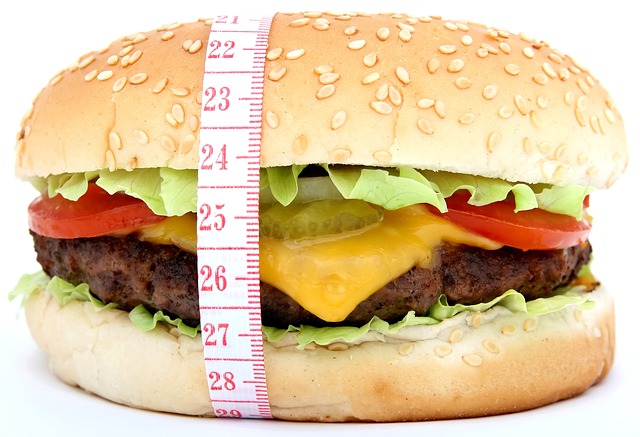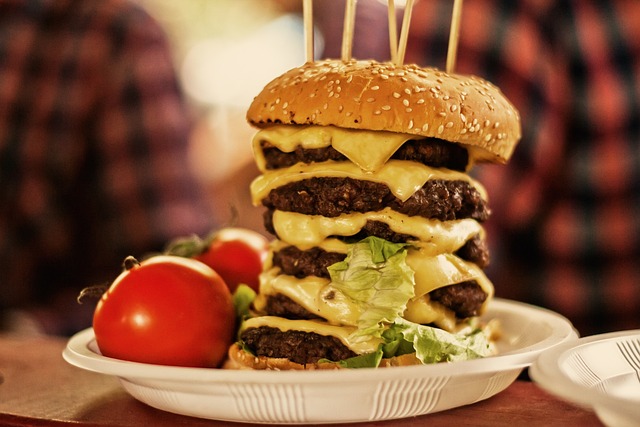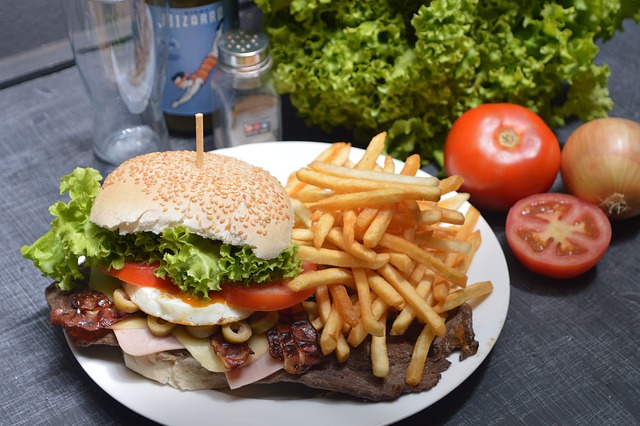The number of burgers from a cow depends on factors like its size and meat cuts used. On average, a cow yields 450-600 pounds of meat. With 1/3 pound per patty, you might get 1,350-1,800 burgers from one cow, considering factors like patty size and meat distribution.
In addition, It’s important to note that a cow provides a variety of cuts beyond just ground beef, such as steaks, roasts, and other parts that might not be used for burgers. The distribution of cuts and the ratio of ground beef to other cuts will influence the final number of burgers you can get from a single cow.
How Can You Calculate Burger Quantity?
Quantifying the culinary delight of burgers involves a blend of culinary precision and mathematical consideration.
Standard Burger Patty Weight: 1/3 Pound (5.3 Ounces)
The weight of a standard burger patty is often considered to be around 1/3 pound, which is approximately 5.3 ounces.
In addition, this weight is a common choice in many restaurants and households and provides a good balance between meatiness and cookability.
However, it’s important to note that burger patty sizes can vary based on personal preferences and regional standards.
Estimation of Burger Patties per Cow
Based on Average Meat Yield: To estimate the number of burger patties a single cow can yield, we can start with the average meat yield range of 450-600 pounds obtained from the cow. If we assume the use of 1/3 pound burger patties, we can calculate the range as follows:
- Minimum burgers: 450 pounds / (1/3 pound per patty) = 1,350 patties
- Maximum burgers: 600 pounds / (1/3 pound per patty) = 1,800 patties
This calculation provides a rough estimate of the potential burger yield based on the average meat yield of the cow.
Factoring in Patty Weight: The actual number of burger patties can vary based on the patty weight chosen and other factors like meat distribution and utilization of different cuts.
However, if you decide to use thicker or thinner patties, it will affect the number of patties you can get from the same amount of meat. Adjusting the patty weight will directly impact the final count:
- Heavier patties (e.g., 1/2 pound each) would result in fewer burger patties.
- Lighter patties (e.g., 1/4 pound each) would result in more burger patties.
Moreover, since other cuts beyond ground beef are obtained from a cow, the exact distribution of these cuts among various products will influence the overall burger count.
Factors Influencing Patty Quantity:
- Preferences: Different people prefer varying patty sizes, affecting the total count.
- Usage of Other Cuts: Depending on the proportion of meat used for non-burger cuts, the available meat for burgers will change.
- Processing Efficiency: How effectively the meat is extracted during processing affects the final usable meat yield.
What Are The Key Factors That Influence the Count of Burgers?

Behind the savory delight of burgers lie key factors that wield influence over their count
Cow’s Size:
The size of the cow, often correlated with its weight and age, plays a significant role in determining the amount of meat it can provide.
Additionally, larger cows tend to have more muscle mass and therefore yield more meat. Factors such as breed, genetics, and overall health also influence a cow’s size and, consequently, its meat yield.
Furthermore, younger cows might have more tender meat suitable for burgers, while older cows could provide tougher cuts better suited for roasting or stewing.
Types of Meat Cuts:
Different cuts of meat are obtained from a cow, ranging from tender steaks to ground beef for burgers. Moreover, the distribution of these cuts affects the number of burgers you can produce.
While ground beef is commonly used for burgers, premium cuts like sirloin, ribeye, and filet mignon are also sourced from a cow. Additionally, these cuts are typically not used for burgers, but their presence affects the overall meat yield and variety.
Patty Thickness:
The thickness of burger patties impacts the number of burgers you can make from a given amount of meat. Thicker patties require more meat per patty, reducing the total number of burgers.
Conversely, thinner patties use less meat, allowing for a higher burger count. However, patty thickness isn’t solely about quantity; it also affects cooking time, taste, and texture.
Moreover, the balance between the number of burgers and the desired patty characteristics must be considered.
Lean-to-Fat Ratio:
The ratio of lean meat to fat in the ground beef mixture is another crucial aspect. Lean meat produces denser, less fatty patties, while higher-fat ratios lead to juicier burgers.
Additionally, the distribution of lean and fatty meat cuts from the cow impacts the overall composition of the burger patties.
Different preferences for meat fattiness can influence the amount of ground meat required and consequently affect the total burger count.
Other Cuts and Byproducts:
A cow provides various cuts of meat beyond ground beef and burger patties. These include roasts, stewing cuts, brisket, and more.
Furthermore, these cuts might not be suitable for burgers but are essential for diverse culinary uses. Factoring in these other cuts and byproducts adds complexity to estimating the number of burgers from a cow.
Processing Efficiency:
The efficiency of the meat processing process also influences the amount of usable meat. Moreover, proper butchering, trimming, and preparation impact the yield of meat suitable for making burgers. Inefficient processing might result in more waste, affecting the ultimate burger count.
How Can Estimate Meat Yield from a Cow?
Navigating the realm of livestock, estimating meat yield from a cow demands a comprehensive understanding of factors like breed, age, and carcass composition.
Average Meat Yield Range: 450-600 Pounds
The meat yield from a cow refers to the amount of usable meat obtained after processing the animal.
On average, a cow can yield anywhere between 450 to 600 pounds of meat. This yield includes various cuts such as steaks, roasts, ground beef, and other meat products.
However, this range can vary based on factors like the cow’s size, genetics, and overall health.
Size and Weight: Larger cows generally yield more meat due to their increased muscle mass. The age at which a cow is processed also matters; younger cows may have more tender and desirable cuts.
Breed and Genetics: Different cattle breeds have distinct body compositions, affecting the distribution of meat cuts. Some breeds are specifically raised for meat production and might yield more meat compared to dairy breeds.
Health and Nutrition: A cow’s health, diet, and overall care impact its muscle development and, consequently, its meat yield. Well-nourished and healthy cows tend to provide higher-quality meat.
Usable Meat After Processing
The usable meat yield is the portion of the animal that can be processed and consumed. This includes cuts of meat that are suitable for various culinary purposes.
During processing, certain parts of the cow might not be used for meat due to factors like toughness or lack of desirability.
However, advancements in meat processing techniques have improved the utilization of different parts of the animal.
Variability Due to Factors Like Breed and Age
The estimated meat yield range (450-600 pounds) is just an average and can vary significantly based on factors like breed and age:
Breed: Different cattle breeds have varying proportions of muscle mass and fat, leading to differences in meat yield.
For instance, beef cattle breeds are bred for meat production and tend to yield more meat compared to dairy cattle.
Age: Younger cows, usually processed around 18-24 months, generally have more tender and desirable cuts suitable for burgers and other premium meat products.
Older cows may have tougher meat and are often used for products like ground beef.
Gender: Male cattle (steers and bulls) generally yield more meat than females (heifers and cows) due to their larger size.
Processing Methods: Modern processing techniques, such as advanced butchering practices, have improved the efficiency of meat extraction, potentially affecting the overall meat yield.
What factors impact the count and how?

The size of burger patties directly impacts the total count of patties that can be made from a cow’s meat.
Varying patty sizes alter the distribution of the meat, affecting the overall yield of burger patties.
Variations in Patty Size:
Thicker Patties: Opting for thicker patties (e.g., 1/2 pound) results in fewer patties per cow but offers a heartier eating experience. This reduces the overall burger count.
Thinner Patties: Moreover, choosing thinner patties (e.g., 1/4 pound) increases the number of patties obtained from the same meat amount. This elevates the burger count but may sacrifice some juiciness and texture.
It’s important to strike a balance between patty size and the desired eating experience, as well as to consider the preferences of those who will be enjoying the burgers.
Incorporating Lean and Fatty Meat:
Burger patties often benefit from a balanced ratio of lean meat and fatty meat. While lean meat contributes to the patty’s structure, fatty meat adds juiciness and flavor. The incorporation of both types of meat affects the total count of burger patties:
Lean Patties: If patties are made primarily from lean meat, they may be denser and less juicy.
Additionally, this might lead to the use of more meat per patty to achieve a satisfying texture, resulting in fewer patties.
Fatty Patties: Using fattier meat produces juicier and more flavorful patties. While they might be more desirable.
Moreover, their higher fat content can limit the number of patties that can be made from a given meat amount.
Achieving the desired balance between lean and fatty meat involves considering the overall composition of the burger patties and their impact on the total count.
Other Meat Cuts Obtained from a Cow:
A cow provides a diverse range of meat cuts beyond just ground beef suitable for burgers. Additionally, these include steaks, roasts, stewing cuts, and more. The allocation of these cuts affects the overall yield of meat available for burger patties:
Premium Cuts: Some cuts, like ribeye or tenderloin, are prized for their tenderness and flavor and are generally not used for burgers. These cuts decrease the amount of meat available for ground beef.
Secondary Cuts: Other cuts might not be as desirable for standalone dishes but are great for ground beef. Using these cuts for burgers can increase the overall patty count.
Considering the utilization of various meat cuts contributes to a holistic understanding of the cow’s meat distribution and its impact on the burger count.
FAQ’s
How many cows are in 1 burger?
The meat from multiple cows is typically combined to make one burger patty.
How much can you get out of one cow?
On average, one cow can yield around 450-600 pounds of usable meat after processing.
How many cows does McDonald’s use?
McDonald’s sources meat from a network of suppliers, so the number of cows used can vary widely.
How much beef for one burger?
A standard burger patty weighs around 1/3 pound (5.3 ounces) on average.
Who is the largest beef producer?
As of my knowledge cutoff in September 2021, the United States and Brazil are among the largest beef-producing countries.
Does McDonald’s use bull meat?
McDonald’s primarily uses meat from steers, which are castrated male cattle, for their beef products.
Which country is No 1 in beef export?
As of my last update, Brazil has been one of the leading exporters of beef.
What country eats the most beef?
Historically, countries like the United States, Argentina, and Brazil have had high levels of beef consumption.
Conclusion
Estimating the number of burger patties obtained from a single cow is a multifaceted endeavor influenced by a range of factors. From the cow’s size and breed to the distribution of meat cuts and the desired characteristics of the patties, each element plays a crucial role in determining the final count.
While the average meat yield range of 450-600 pounds provides a foundational estimate, customization through considerations like patty size and the incorporation of lean and fatty meat allows for tailoring the burger count to specific preferences.
Moreover, acknowledging the diverse cuts of meat obtained from a cow, some suitable for premium dishes and others for ground beef, underscores the complexity of the process.
In addition, striking a balance between optimizing the number of burger patties and ensuring a high-quality culinary experience calls for a thoughtful approach that considers the intricate interplay of these factors.
In essence, the journey from cow to burger patties highlights the art of meat processing, distribution, and customization.
By understanding the depth of these considerations, we gain insight into the craftsmanship involved in transforming a single cow into a delightful array of delectable burgers.











